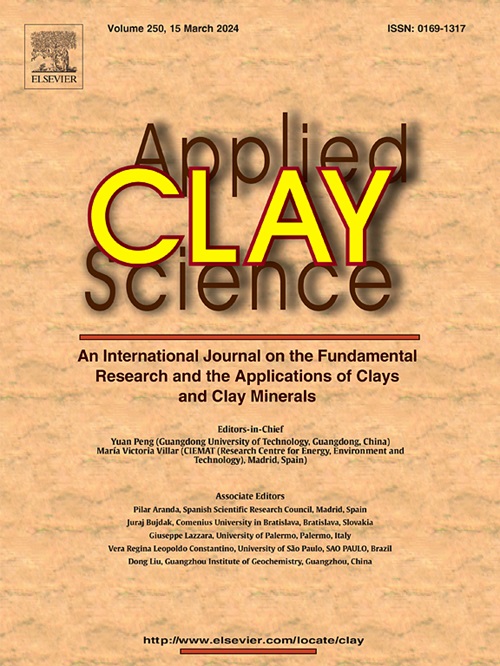High-performance dickite strengthened double-crosslinked hydrogel electrolytes for aqueous zinc-ion batteries
IF 5.3
2区 地球科学
Q2 CHEMISTRY, PHYSICAL
引用次数: 0
Abstract
The development of flexible devices has imposed higher demands on the mechanical and electrochemical properties of hydrogel electrolytes. To enhance the mechanical properties of hydrogels, this study prepared a composite hydrogel (P-D30-DIOH1) composed of covalently crosslinked polyacrylamide (PAM), diacetone acrylamide (DAAM), and expanded dickite (DIOH). The results indicated that PAM and DAAM could form a dual crosslinked network structure through hydrogen bonding and molecular chain entanglement, thereby improving the mechanical properties of the hydrogel. Furthermore, the surface of dickite, which is rich in -OH and Si![]() O groups, could simultaneously form hydrogen bonds with PAM and DAAM, thus acting as an inorganic crosslinking agent. After expansion treatment, the dickite layers were fully exposed, increasing the specific surface area and further enhancing the physical crosslinking effect of dickite. Mechanical testing revealed that the tensile strength of the DAAM and DIOH reinforced P-D30-DIOH1 hydrogel reached 0.374 MPa, with a tensile elongation of 2100 % and a compressive strength of 0.308 MPa at 75 % deformation. P-D30-DIOH1 hydrogel electrolyte exhibited a high ionic conductivity (20.7 mS cm−1), attributed to the negatively charged expanded dickite, which enriched Zn2+ and formed rapid Zn2+ transport channels under the electric field. The P-D30-DIOH1 hydrogel effectively stabilized the surface of the Zn anode, inhibited the growth of Zn dendrites, and reduced the formation of by-products. When the P-D30-DIOH1 hydrogel electrolyte was assembled into the MnO2//Zn battery, it operated stably for 700 cycles, maintaining a specific discharge capacity of 118 mAh g−1 at a current density of 150 mA g−1. Moreover, the battery delivered a specific discharge capacity of 270 mA h g−1 at 60 mA g−1, and even at 600 mA g−1, it retained a high reversible capacity of 115 mAh g−1, demonstrating excellent electrochemical performance. Furthermore, the assembled flexible battery continued to function effectively under physical deformations such as bending, impact, and puncture.
O groups, could simultaneously form hydrogen bonds with PAM and DAAM, thus acting as an inorganic crosslinking agent. After expansion treatment, the dickite layers were fully exposed, increasing the specific surface area and further enhancing the physical crosslinking effect of dickite. Mechanical testing revealed that the tensile strength of the DAAM and DIOH reinforced P-D30-DIOH1 hydrogel reached 0.374 MPa, with a tensile elongation of 2100 % and a compressive strength of 0.308 MPa at 75 % deformation. P-D30-DIOH1 hydrogel electrolyte exhibited a high ionic conductivity (20.7 mS cm−1), attributed to the negatively charged expanded dickite, which enriched Zn2+ and formed rapid Zn2+ transport channels under the electric field. The P-D30-DIOH1 hydrogel effectively stabilized the surface of the Zn anode, inhibited the growth of Zn dendrites, and reduced the formation of by-products. When the P-D30-DIOH1 hydrogel electrolyte was assembled into the MnO2//Zn battery, it operated stably for 700 cycles, maintaining a specific discharge capacity of 118 mAh g−1 at a current density of 150 mA g−1. Moreover, the battery delivered a specific discharge capacity of 270 mA h g−1 at 60 mA g−1, and even at 600 mA g−1, it retained a high reversible capacity of 115 mAh g−1, demonstrating excellent electrochemical performance. Furthermore, the assembled flexible battery continued to function effectively under physical deformations such as bending, impact, and puncture.
求助全文
约1分钟内获得全文
求助全文
来源期刊

Applied Clay Science
地学-矿物学
CiteScore
10.30
自引率
10.70%
发文量
289
审稿时长
39 days
期刊介绍:
Applied Clay Science aims to be an international journal attracting high quality scientific papers on clays and clay minerals, including research papers, reviews, and technical notes. The journal covers typical subjects of Fundamental and Applied Clay Science such as:
• Synthesis and purification
• Structural, crystallographic and mineralogical properties of clays and clay minerals
• Thermal properties of clays and clay minerals
• Physico-chemical properties including i) surface and interface properties; ii) thermodynamic properties; iii) mechanical properties
• Interaction with water, with polar and apolar molecules
• Colloidal properties and rheology
• Adsorption, Intercalation, Ionic exchange
• Genesis and deposits of clay minerals
• Geology and geochemistry of clays
• Modification of clays and clay minerals properties by thermal and physical treatments
• Modification by chemical treatments with organic and inorganic molecules(organoclays, pillared clays)
• Modification by biological microorganisms. etc...
 求助内容:
求助内容: 应助结果提醒方式:
应助结果提醒方式:


